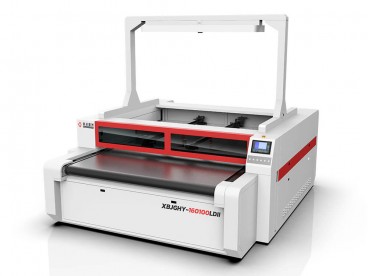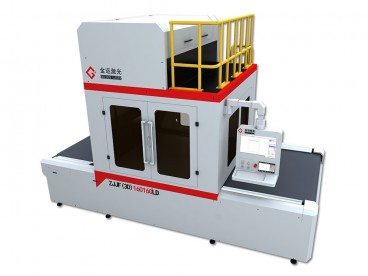Add Laser Engraving and Cutting of Textile to your Product Line
Engraving or cutting fabric is one of the most typical applications for CO2 laser machines. Laser cutting and engraving of fabrics has become increasingly popular in recent years. Today, utilizing laser cutting machines, manufacturers and contractors can quickly and easily produce jeans with intricate cut-outs or laser-engraved logos, and can also engrave patterns onto fleece jackets or contour-cut two-layer twill appliqués for sports uniforms.
CO2 laser cutting machine can be used to process polyester, nylon, cotton, silk, felt, glass fibre, fleece, natural fabrics as well as synthetic and technical textiles. It can even be used to cut particularly strong materials such as Kevlar and Aramid.

The real benefit of using lasers for textiles is that basically any time these fabrics are cut, a sealed edge is obtained with the laser, as the laser just performs a non-contact thermal process to the material. Processing textiles with a laser cutting machine also makes it possible to obtain complex designs at a very high speed.
Laser machines are used for engraving or cutting directly. For laser engraving, the sheet material is placed on the working platform or the roll material is pulled off roll and onto machine, and then laser engraving is performed. To engrave on fabric, the laser can be dialed in for depth to get contrast or a light etch that bleaches the color out of the fabric. And when it comes to laser cutting, in the case of making decals for sports uniforms, for example, laser cutter can out a design on material that has heat-activated adhesive on it.
The response of textiles to laser engraving varies from material to material. When engraving fleece with a laser, this material does not change color, but simply removes a portion of the material’s surface, creating a distinct contrast. When using various other fabrics such as twill and polyester, laser engraving usually results in a color change. When laser engraving cotton and denim, a bleaching effect is actually produced.
In addition to cutting through and engraving, lasers can kiss cut as well. For the production of numbers or letters on jerseys, laser kiss cutting is a very efficient and accurate cutting process. First, stack multiple layers of twill in different colors and adhere them together. Then, set the laser cutter parameters just enough to cut through the top layer, or just the top two layers, but with the backing layer always intact. Once the cutting is complete, the top layer and the top two layers can be torn apart to create nice looking numbers or letters in different layers of color.
In the past two or three years, the use of lasers to decorate and cut textiles has really become very popular. The large influx of laser-friendly heat transfer materials can be cut into text or different graphics, and then placed on the T-shirt with a heat press. Laser cutting has become a fast and efficient way to customize T-shirts. In addition, lasers are widely used in the fashion industry. For example, laser machine can engrave designs on canvas shoes, engrave and cut complex patterns on leather shoes and wallets, and engrave hollow designs on curtains. The whole process of laser engraving and cutting fabric is very interesting, and unlimited creativity can be realized with laser.
Wide-format sublimation printing, as an emerging technology, is radiating vitality in the digital printing textile industry. There are new printers coming out that allow a business to print directly on fabric rolls of 60 inches or larger. The process is great for low-volume, custom garments and flags, banners, soft signage. This means that lots of manufacturers are looking for the efficient way to print, cut, and sew.
The image of a garment that has a complete wrap graphic on it is printed out onto transfer paper then sublimated onto a roll of polyester material using a heat press. Once it is printed, the different pieces of the garment are cut out and sewn together. In the past, the cutting work was always done by hand. The manufacturer hopes to use a technology to automate this process. Laser cutting machines enable designs to be cut out along contours automatically and at high speed.
Textile manufacturers and contractors looking to expand their product lines and profit potential may consider investing in a laser machine to engrave and cut fabrics. If you have a production idea that requires laser cutting or engraving, please contact us and our Goldenlaser team will find a laser solution that best suits your needs.




